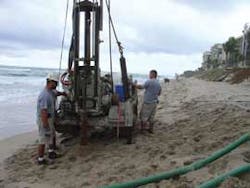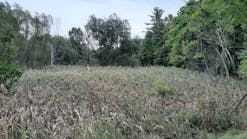Nature knows best. This is the premise behind the approach that many contractors have taken on their sites in recent years. It has been a common trend for contractors to use bioengineering techniques or soft-armor erosion control solutions, including erosion control blankets, coir logs, and vegetation alone, to hold soil in place rather than to opt for hard-armor solutions, such as poured concrete or riprap.
Environmentally friendly bioengineering is an approach that can be effective in many, but not all, cases.
Stabilizing a site with steep slopes, a site at risk for flooding, or sites that must withstand high-velocity water flows can require help from manmade or synthetic solutions in order to prevent greater or more widespread damage. Structural erosion control can stabilize sites that are dramatically challenged by nature itself.
Hard-armor solutions, which can range from retaining walls and gabions to concrete shoreline protection measures, can provide long-term protection at sites where soft-armor engineering systems are not enough. Yet many companies find employing a combination of both of these techniques can promise the best of both worlds for particularly challenging sites.
Preventing Hillside Erosion in Oahu
When one thinks of the Hawaiian island of Oahu, erosion typically isn’t the first image that comes to mind. Yet Hawaii’s department of transportation hired Prometheus Construction to protect a section of the Pali Highway two years ago to protect this side of paradise.
“The site had global instability problems with a history of landslides,” says Cliff Tillotson, vice president of Prometheus Construction, a company that specializes in rockfall mitigation and slope stabilization with offices in Santa Barbara, CA, and Kaneohe, HI.
A hydraulic erosion blanket with seed had been used at the site in the past, but it had failed. Geobrugg Protection System’s TECCO rockfall drape, made of high-tensile steel wire mesh, was selected to protect the roadway.
“TECCO was chosen, with varying depths of soil nail anchors to tie the hillside back beyond its slip plane. The anchors were 10 to 30 feet deep,” says Tillotson, adding that a combination of erosion control techniques was employed on the project. “For surface erosion, a North American Green C350 coconut-fiber turf reinforcement mat was installed. The hillside was also hydroseeded with Kikuya grass before the installation of the blanket and the TECCO.”
Site workers had to cope with a challenge of timing: the erosion control products’ installation took place during the island’s rainy season.
“To prevent erosion during construction, before we removed most of the existing vegetation, we drilled and installed all the anchors that we could reach with our excavator. Then, we stripped the hillside of its existing vegetation so we could get the erosion blanket and TECCO to lay flat. Then we did the hydroseeding and installed the coconut blanket and TECCO,” says Tillotson. “After this was competed, which only took a few days, we drilled and installed all the upper anchors.”
The slope was approximately 80 to 100 feet high, and bencher drills were mounted on man-lifts, he explains.
“This approach tightened the window of vulnerability to erosion from rainstorms here in Hawaii before we got the permanent system complete with all the anchors in place,” says Tillotson.
Even with the rainy weather, measures were taken to ensure proper germination.
“We also installed temporary irrigation,” he says, “to speed revegetation.”
As areas adjacent to the construction site continue to erode significantly, the TECCO section remains steadfast.
Keeping Beach Erosion at Bay in Florida
It’s difficult to watch pieces of your present environment drift away, but that’s exactly what residents of Hillsboro Beach were forced to witness as they lost approximately 2 feet of beach annually to erosion. Although a full beach renourishment took place at the site about nine years ago, the town, located beside Ft. Lauderdale on Florida’s Atlantic Coast, had to bring in sand repeatedly to counter the natural erosion caused by storms and winter tides.
“We decided you just can’t keep replacing sand,” says town commissioner Tom Puleri. “It’s too costly.”
In 2008, the town leased Boca Raton, FL-based EcoShore International’s pressure equalizing module (PEM) system for three years. The system is designed to alter water pressure within sediment using tubes with drainage outlets to increase the sediment deposition on a beach. If it didn’t work, the company would remove the system at no cost.
“In the contract, there were stipulations on how to determine whether it worked,” explains Puleri. “They do surveys, approved by the DEP [Department of Environmental Protection]. If it showed they met the requirement of the contract, we would pay them 50% of the annual rent.”You could not lose more than 25% of the beach, and you had to gain 25%,” he continues. “As long as you stayed within those two numbers, they considered it successful.”
These surveys, he says, must be confirmed by the state of Florida. The project can potentially save the city millions of dollars in erosion control costs in the future, according to an article in the local newspaper, the Sun-Sentinel, which reported Broward County beach erosion commissioner Stephen Higgins as saying the area’s beaches protect $4 billion in public and private property.Each 6-foot-long, 2.5-inch-diameter tube contains drainage slots. A small drill mounted on tracks digs a 9- to 10-foot hole in the sand. The PEMs are then vertically inserted in these holes in 33 rows.The distances between the tubes’ tops and the existing grade range from 12 to 36 inches, according to a statement by EcoShore. The rows are spaced 50 meters apart and run perpendicular to the shoreline. The PEMs themselves have been placed 10 meters apart, according to the company, with “each row beginning from the mean low water line and extending to the toe of the dune or to structures that armor the shore.” The installation process at Hillsboro Beach took approximately three weeks.While there are slightly less than 4 miles of beach at the site, the DEP would allow the PEM system to be applied only on 1 mile of the site so that it could be studied.”We had to wait until turtle season-the laying of the eggs-was over before the installation,” says Puleri. “That was one of the things we had to contend with. And it’s a long process getting the permits. So far, we have had no problems whatsoever. It seems to be working. We’ll do another survey in six months. We lost a little beach, but we gained density.”Regular beach nourishment, involving barges off the coast pumping sand onto the beach, was used in addition to establishing the PEM system, says Puleri, who is happy with the way the system has worked so far.
Preventing River Flooding in Minnesota
Railroad ties and timbers were used to stabilize and prevent erosion in an area along the Redwood River, one of 13 watersheds that flow into the Minnesota River. But when this method gave way, it caused a scouring problem within the river itself, and the area’s soil conservation service turned to Gabions Inc. for a more effective solution.Erv Niehaus, president of Gabions Inc., a Litchfield, MN-based supplier and sometime-installer of Terra Aqua Gabions’ products, explains that a bypass had been installed around the city of Marshall, MN, where the site was located, to prevent flooding. However, flooding that had taken place in the area prior to that construction had caused the erosion at the site.
“I designed a retaining wall. It was joint project with the local soil conservation agency and homeowners. They engaged us to put it in place,” says Niehaus. “It consisted of cleaning up the mess that was there. We cleaned up the scour hole in the river. It was a one-pass installation.
“Stretching approximately 500 feet long, the wall extended to 12 feet high at one end. Terra Aqua’s gabions are a double-twisted hexagonal woven mesh, made from galvanized steel with compartmented baskets forming a rectangular box. Natural stone is placed in the product’s cells.In 2004, the company installed a Reno mattress at the site. Stone is evenly distributed into the equal-sized cells of the double-twist hexagonal woven mesh that is made of galvanized steel. The rectangular-shaped mattresses, as well as gabions, have been used internationally for more than a century in a wide variety of applications, including soil retention, river training, and channel linings.”The mattress provided the foundation and scour protection for the wall,” says Niehaus. “There was a bridge on the state highway next to it. We terminated the wall when we got to the bridge. There were some storm sewers that also contributed to the erosion. We also extended the pipe through the gabion wall.”Eventually, explains Niehaus, the site will revegetate itself as the Reno mattress catches seed and sediment through the years. Now that the project is complete, he drives by the site frequently.”It’s held up,” says Niehaus. “It’s doing fine.”
Stabilizing Canal Banks in Tampa
In July 2008, parts of the embankment of the C-24 canal located in St. Lucie and Martin counties in Florida collapsed into the canal as the result of a hurricane. The manmade canal had held steady since its 1959-1961 construction by the US Army Corps of Engineers, but hurricanes can test the strongest of support mechanisms.To stabilize the area, Tampa-based R. H. Moore & Associates used Maccaferri gabion walls for the canal’s banks. Crews also employed turbidity barriers from Bradenton, FL-based Aer-Flo Inc. to contain sediment during the project.
These floating barriers can prevent sediment and silt from entering water courses. To be most effective, however, certain measures must be taken, including containing the silt and sediment in the retention area long enough to permit settling. The containment area’s current shouldn’t be so intense that the particles are permitted to migrate past the barrier before settlement can occur.The barrier’s lower edge is typically kept approximately 1 foot above the bottom of the waterway. If the lower edge is long enough to drape the bottom, silt will begin to build up, and if this is permitted to occur over an extended period of time, the barrier can be drawn below the water’s surface.The double-twisted hexagonal mesh of the Maccaferri gabions’ steel wire is reinforced by selvedges of heavier wire. These gabions are pre-assembled for quick installation. The tops of the gabions and the embankment behind them were sodded.Because four projects with four different contractors were going on simultaneously in the area, workers also faced a time constraint: the project required a 21-day turnaround.This affected the choice of contractor.
“Aer-Flo had easily the quickest response,” says Larry Larson Jr. of R. H. Moore & Associates, who adds that using local manufacturing can drive down a project’s costs slightly. “They have great quality and are very well-known in the state of Florida.”
Gabions Protect Stream Bank
Texas flooding is legendary, immortalized in books and song. For a stream restoration project located in a flood plain in Carrollton, TX, the city hired DCI Contracting Inc., based in Decatur, TX, to combat a large volume of water overflow.Beginning in late February 2008, DCI used Houston-based Modular Gabion Systems’ product for erosion control at the Hutton Branch Channel site. These gabions were chosen for their ease of installation compared with twisted-wire gabions that DCI had used in the past. In addition, “the welded wire gave us a little more of a uniform look,” says Shannon DiMarco, the project superintendent for DCI.
“For this project DCI chose the “˜roll stock’ welded wire mesh gabion construction method, instead of the conventional partially assembled gabions,” says George Ragazzo, general manager of Modular Gabion Systems. “The roll stock method is one of MGS’s innovations, which allows the contractor to field-form gabions and gabion mattresses up to 300 feet long continuously and without joints, thus eliminating all redundant common panels and a great deal of the labor associated with conventional gabions construction.”
The roll stock is supplied in rolls of welded-wire mesh to contract specifications engineered for the project. It requires less gabion material, less labor, and less installation time-typically from 40% to 70% less time. The resulting gabion structure is more structurally sound-no joints, highly flexible, very cost effective, and aesthetically superior.”The spiral fasteners, commonly used with welded-wire gabion installation, offer a joint strength of 1,834 pounds per foot and allow stress that develops from opposing panels to be evenly distributed along the joint, according to Modular Gabion Systems. The gabions’ self-supporting nature allows for ease of assembly, and the PVC powder coating that is fuse-bonded to the welded mesh helps to prevent corrosive liquids from damaging the core wire.Workers overcame weather challenges at the site to construct massive retaining walls.”We used the gabions to build a couple of retaining walls, one 300 feet by 12 feet tall,” DiMarco says, adding that the company also installed gabions along both sides of the waterway. “The channel itself is roughly a mile. We’ve installed 7,000 cubic yards so far.”
Workers used a combination of erosion control techniques at the site during the $4.5 million project, which also includes the addition of three bridges and a low-water stream crossing. These additional techniques include geotextiles, coir matting, and a high-performance turf reinforcement mat.”Above the gabion channels, they installed coconut straw and seed/grass mixes that go beneath the fabrics,” says DiMarco. “The flow channel of the stream is built with the gabion basket. It works great. The city of Carrollton is very pleased with the outcome.”
Slope Restoration
While a slope restoration project at Miller’s Creek in Ann Arbor, MI, required some revegetation for erosion control, the site also needed a hard-armor solution for long-term erosion protection.The creek, which snakes beside Huron Parkway, lies within about 50 feet of the roadway.”It was a restoration of the banks that had already caved in and washed out,” says Brack Moss, who managed the ongoing project for Posen Construction. “It was a pretty good area that was already eroded. Some of the trees had fallen into the stream.”The company used a Cable Concrete system produced by International Erosion Control Systems in Ontario, Canada, on the three-quarter-mile site.
Flexible stainless steel cable is integrated into concrete, forming many interlocking cells that combine to create a mat. The cable’s flexibility permits the mat to correspond with ground contours. The mats, which can be installed below or above water levels, arrive at a site as a unit, which can reduce labor costs.The Cable Concrete system is typically paired with a geotextile base cloth. Holes in this geotextile allow drainage into the subsoil, preventing hydraulic pressure buildup beneath the concrete mat.”The Cabled Concrete was installed in the worst curve, the curve that had the most erosion,” says Larry Libbrecht of CSI Geoturf based in Highland, MI, which represented the manufacturer for this site.
The mat lined 120 feet of the area and was filled in with topsoil. A variety of wildflowers, native seed mixes, and prairie grass plugs were added; when they mature, the vegetation will cover the mat, says Moss. Ninety percent of the $565,000 project was spent on erosion control.Keeping the road open during construction was a challenge for workers, who found themselves beside the traffic in places on the site.”We diverted the water that was in the stream so we could do the work where it was dry,” says Moss. “Each one we got finished, we’d open it up.”
Also used on the project was Propex Geosythetics’ Landlok 450 synthetic turf reinforcement mat, which “allows vegetation while protecting the slope from erosion,” explains Libbrecht. The mats are designed for both short- and long-term protection in moderate flow waterways, such as certain creeks. Soil, seed, and water are held in place using the company’s X3 fiber technology. This TRM is composed of completely synthetic, ultraviolet-stabilized elements.Posen also installed a riprap toe at the site that met the water’s edge on one side and the articulated concrete on the other.Willow stakes were used at the site, explains Moss, who notes that the process creates a root system that will prevent erosion as well as providing a natural aesthetic. Willow was selected because it thrives around watery areas. Sandbar willow, pussy willow, silky willow, peachtree willow, and black willow were used at the site. Other vegetation used on site included red-osier dogwood, silky dogwood, and ninebark.This touch of green will soften the edges of the landscape around the project for years to come.
The severity of erosion-or its potential-that a site faces can greatly affect and effectively limit a project’s choice of erosion control methods. When a natural approach is what you want but manmade strength is what you need, consider the variety of ways you can incorporate erosion control solutions that combine both methods, providing the kind of strength with a natural appearance clients often desire.






